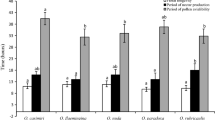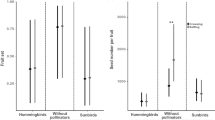Abstract
The reproductive biology of Pringlea antiscorbutica R. Br. (Brassicaceae), an endemic species from the southern Indian Ocean islands, is investigated here. Controlled crosses were performed between plants grown in a common garden on the Kerguelen Islands. Searching for potential insect pollinators, we investigated the flying ability of all insects known from the Kerguelen Islands. We showed evidence for self-compatibility, low pollen limitation in the absence of a biotic pollen vector and slight selfing depression in P. antiscorbutica. The insects present on the islands are mostly wingless and are not likely to be efficient pollinators of this species. Since P. antiscorbutica shows morphological adaptations to insect pollination despite the absence of pollinators in its present range, we conclude that this species recently evolved from insect pollination to wind and/or autonomous pollination.




Similar content being viewed by others
References
Al-Shehbaz IA, Beilstein MA, Kellogg EA (2006) Systematics and phylogeny of the Brassicaceae (Cruciferae): an overview. Plant Syst Evol 259:89–120
Ashman TL, Knight TM, Steets JA, Amarasekare P, Burd M, Campbell DR, Dudash MR, Johnston Mazer S, Mitchell RJ, Morgan MT, Wilson WG (2004) Pollen limitation of plant reproduction: ecological and evolutionary causes and consequences. Ecology 85:2408–2421
Aubert S, Assard N, Boutin JP, Frenot Y, Dorne AJ (1999) Carbon metabolism in the subantarctic Kerguelen cabbage Pringlea antiscorbutica R. Br.: environmental controls over carbohydrates and proline contents and relation to phenology. Plant Cell Environ 22:243–254
Baker HG (1955) Self compatibility and establishment after “long-distance” dispersal. Evolution 9:347–348
Barrett SCH (1998) The evolution of mating strategies in flowering plants. Trends Plant Sci 3:335–341
Bergstrom DM, Chown SL (1999) Life at the front: history, ecology and change on Southern Ocean Islands. Trends Ecol Evol 14:472–477
Bertin RI, Newman CM (1993) Dichogamy and angiosperms. Bot Rev 59:112–152
Chapuis JL, Hennion F, Le Roux V, Le Cuziat J (2000) Growth and reproduction of the endemic cruciferous species Pringlea antiscorbutica in Kerguelen Islands. Polar Biol 23:196–204
Chapuis JL, Frenot Y, Lebouvier M (2004) Recovery of native plant communities after eradication of rabbits from the subantarctic Kerguelen islands and influence of climate change. Biol Conserv 117:167–179
Charlesworth D (2003) Effects of inbreeding on the genetic diversity of populations. Philos Trans R Soc Lond B:1–20
Charlesworth D, Charlesworth B, (1979) The evolution and breakdown of S-allele systems. Heredity 43:41–55
Charlesworth D, Charlesworth B (1987) Inbreeding depression and its evolutionary consequences. Annu Rev Ecol Syst 18:237–268
Chown SL (1994) Historical ecology of sub-Antarctic weevils (Coleoptera: Curculionidae): patterns and processes on isolated islands. J Nat Hist 28:411–433
Chown SL, Gremmen NJM, Gaston KJ (1998) Ecological biogeography of southern ocean islands: Species-area relationships, human impacts, and conservation. Am Nat 152:562–575
Culley TM, Weller SG, Sakai AK (2002) The evolution of wind pollination in angiosperms. Trends Ecol Evol 17:361–369
Dahl C (1970) Diptera: Trichoceridae of Kerguelen Islands. Pac Insect Monogr 23:274–275
Denisow B (2004) Dynamics of blooming and insect visits on several (Brassicaceae = Cruciferae Juss.) species. J Apic Sci 48(2):13–22
Dorne AJ, Bligny R (1993) Physiological adaptation to subantarctic climate by the Kerguelen cabbage, Pringlea antiscorbutica R, Br. Polar Biol 13:55–60
Duckhouse DA (1970) Psychodidae of South Georgia, Heard and Kerguelen. Pac Insect Monogr 23:283–284
Eaton AE (1875) Notes on the entomology of Kerguelen’s Island. Entomol Mon Mag 12:1–2
Eaton AE (1879) Zoology of Kerguelen Island. Lepidoptera. Philos Trans R Soc 168:235–237
Faegri K, van der Pijl L (1971) The principle of pollination ecology, 3rd edn. Pergamon press, Oxford
Fisher RA (1941) Average excess and average effect of agene substitution. Ann Eugen 11:53–63
Frankham R, Ballou JD, Briscoe DA (2002) Introduction to conservation genetics. Cambridge University Press, Cambridge, p 617
Frenot Y, Gloaguen JC, Masse L, Lebouvier M (2001) Human activities, ecosystem disturbance and plant invasions in subantarctic Crozet, Kerguelen and Amsterdam islands. Biol Conserv 101:33–50
Frenot Y, Chown SL, Whinam J, Selkirk PM, Convey P, Skotnicki M, Bergstrom DM (2005) Biological invasions in the Antarctic: extent, impacts and implications. Biol Rev 80:45–72
Gómez JM (2000) Effectiveness of ants as pollinators of Lobularia maritima: effects on main sequential fitness of the host plant. Oecologia 122:90–97
Gressitt JL (1970) Subantarctic entomology and biogeography. Pac Insect Monogr 23:295–374
Hagerup E, Hagerup O (1953) Thrips pollination of Erica tetralix. New Phytol 52:1–7
Harrison RA (1970) Diptera: Acalypterates of South Georgia, Heard and Kerguelen. Pac Insect Monogr 23:285–289
Hennion F (1992) Etude des caractéristiques biologiques et génétiques de la flore endémique des îles Kerguelen. Ph.D. thesis, Muséum National d’Histoire Naturelle, Paris
Hennion F, Bouchereau A (1998) Accumulation of organic and inorganic solutes in the subantarctic Cruciferous species Pringlea antiscorbutica in response to saline and cold stresses. Polar Biol 20:281–291
Hennion F, Martin-Tanguy J (2000) Amines of the subantarctic crucifer Pringlea antiscorbutica are responsive to temperature conditions. Physiol Plant 109:232–243
Hennion F, Walton DWH (1997a) Ecology and seed morphology of endemic species from Kerguelen phytogeographic zone. Polar Biol 18:229–235
Hennion F, Walton DWH (1997b) Seed germination of endemic species from Kerguelen phytogeographic zone. Polar Biol 17:180–187
Hennion F, Frenot Y, Martin-Tanguy J (2006) High flexibility in growth and polyamine composition of the crucifer Pringlea antiscorbutica in relation to environmental conditions. Physiol Plant 127:212–224
Hooker JD (1847) Flora antarctica, part II: 207–574. Reeve Brothers, London, p 574
Hooker JD (1879a) Observations on the botany of Kerguelen Islands. Philos Trans R Soc 168:9–16
Hooker JD (1879b) Enumeration of the plants hitherto collected in Kerguelen Island by the “Antarctic,” “Challenger,” and “British Transit of Venus” expeditions. Flowering plants, ferns, Lycopodiaceae, and Characeae. Philos Trans R Soc 168:17–23
Hullé M, Pannetier D, Simon JC, Vernon P, Frenot Y (2003) Aphids of sub-Antarctic Iles Crozet and Kerguelen: species diversity, host range and spatial distribution. Antarct Sci 15:203–209
Hummel I, Quemmerais F, Gouesbet G, El Amrani A, Frenot Y, Hennion F, Couée I (2004a) Characterisation of environmental stress responses during early development of Pringlea antiscorbutica in the field at Kerguelen. New Phytol 162:705–715
Hummel I, El Amrani A, Gouesbet G, Hennion F, Couée I (2004b) Involvement of polyamines in the interacting effects of low temperature and mineral supply on Pringlea antiscorbutica (Kerguelen cabbage) seedlings. J Exp Bot 55:1125–1134
Husband BC, Schemske DW (1996) Evolution of the magnitude and timing of inbreeding depression in plants. Evolution 50:54–70
Jeannel R (1940) Croisière du Bougainville aux Iles Australes Françaises. III. Coléoptères. Mém MNHN sér A 14:63–201
Kalisz S, Vogler DW (2003) Benefits of autonomous selfing under unpredictable pollinator environments. Ecology 84:2928–2942
Kron P, Husband BC (2006) The effects of pollen diversity on plant reproduction: insights from apple. Sex Plant Reprod 19:125–131
Lloyd DG (1979) Some reproductive factors affecting the selection of self fertilization in plants. Am Nat 113:67–69
Lloyd DG (1992) Self- and cross- fertilization in plants. II. The selection of self-fertilization. Int J Plant Sci 153:370–380
Lyon DL (1992) Bee pollination of facultatively xenogamous Sanguinaria canadensis L. Bull Torrey Bot Club 119:368–375
Marchand D (1995) Mise en réserve des Terres Australes et Antarctiques Françaises. Protection de la flore et des invertébrés autochtones. University of Rennes 1, Rennes Cedex
Mitchell-Olds T, Al-Shehbaz I, Koch MA, Sharbel TF (2005) Crucifer evolution in the post-genomic Era. In: Henry RJ (ed) Plant diversity and evolution, genotypic and phenotypic variation in higher plants. CABI Publishing, Wallingford, pp 119–138
Moore DM (1972) Connections between cold temperate floras, with particular reference to southern South America. In: DH Valentin (ed) Taxonomy, phytogeography and evolution. Academic, London, p 431
Nasrallah LB (1997) Evolution of the Brassica self incompatibility locus: a look into S-locus gene polymorphism. Proc Natl Acad Sci USA 94:9516–9519
Porcher E, Lande R (2005) The evolution of self-fertilization and inbreeding depression under pollen discounting and pollen limitation. J Evol Biol 18:497–508
R Development Core Team (2004) R: a language and environment for statistical computing. R Foundation for Statistical Computing, Vienna, Austria. ISBN 3-900051-07-0, URL http://www.R-project.org
Sakai S (1995) Evolutionary stable selfing rates of hermaphroditic plants with competing and delayed selfing modes with allocation to attractive structures. Evolution 49:557–564
Séguy E (1940) Croisière du Bougainville aux Iles Australes Françaises. IV. Diptères. Mém MNHN sér A 14:203–268
Terry IL (2001) Thrips: the primeval pollinators? In: Marullo R, Mound L (eds) Thrips and tospoviruse. Proceedings of the 7th international symposium on Thysanoptera, CSIRO Entomology, Canberra, pp 157–162
Verrall GH (1879) Zoology of Kerguelen Island. Diptera. Philos Trans R Soc 168:238–248
Vernon P, Vannier G, Tréhen P (1998) A comparative approach to the entomological diversity of polar regions. Acta Ocol 19:303–308
Warwick SI, Al-Shehbaz IA, Price RA, Sauder C (2002) Phylogeny of Sisymbrium (Brassicaceae) based on ITS sequences of nuclear ribosomal DNA. Can J Bot 80:1002–1017
Waterhouse CO (1879) Zoology of Kerguelen Island. Coleoptera. Philos Trans R Soc 168:230–234
Werth E (1911) Die Vegetation der Subantarktischen Inseln Kerguelen, Possession und Heard-Eiland. In: von Drygalski E (ed) Deutsche Südpolar Expedition 1901–1903, part 8. Botanik, Würtzburg, pp 125–371
zur Strassen R (1982) On the Thysanoptera (Insecta) from some islands in the subantarctic part of the Indian Ocean. CNFRA 48:159–169
Acknowledgements
This work was initiated by a grant by UMR 6553 CNRS/University of Rennes 1. Experiments on Kerguelen were supported by the French Polar Institute (Programmes 340, 136 and 407) and the CNRS. We thank R. Douce for coordination of programme 340, J. Leneveu for efficient and meticulous work in Kerguelen, V. Quidelleur and F. Quemmerais for the preliminary experiments, N. Schermann for help with data analysis. We are very grateful to M. Lebouvier and Y. Frenot for their coordination between Rennes and Kerguelen. We thank two anonymous reviewers for useful comments on a previous version of the manuscript, A. Cloarec and R. H. Britton for English improvement.
Author information
Authors and Affiliations
Corresponding author
Rights and permissions
About this article
Cite this article
Schermann-Legionnet, A., Hennion, F., Vernon, P. et al. Breeding system of the subantarctic plant species Pringlea antiscorbutica R. Br. and search for potential insect pollinators in the Kerguelen Islands. Polar Biol 30, 1183–1193 (2007). https://doi.org/10.1007/s00300-007-0275-1
Received:
Revised:
Accepted:
Published:
Issue Date:
DOI: https://doi.org/10.1007/s00300-007-0275-1




